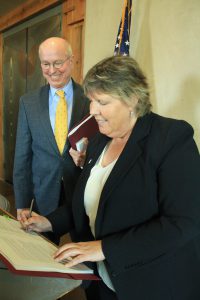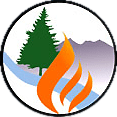Ground-based thinning activities using mechanized equipment require the use of existing forest roads and the construction of new temporary roads to facilitate access to timber stands. In addition, whole-tree skidding of harvested trees requires a network of skid trails ending at landings where trees are delimbed and loaded onto trucks for transport to processing sites (mills, bioenergy facilities, etc.). These activities cause various types of disturbance to soils and ground cover that are mitigated through use of best management practices, known as “BMPs.” Fore more see: Best Management Practices_Final
Harvesting Methods Open House & Firewise Landscaping Contest – Two Exciting Upcoming Events –
The Greater Flagstaff Forests Partnership (GFFP) is pleased to announce an exciting free public event: Harvesting Methods & Wildfire Preparedness Open House on May 7th from 10:00 AM – 1:00 PM at the Aquaplex in Flagstaff. As the pace and scale of forest restoration efforts increase throughout the area, this is an opportunity for the community to experience and learn about the various harvesting methods and the measures taken by professionals to reduce the risk of severe wildfires in our forests. Residents will also have the opportunity to gain valuable insight on how to protect their homes, property, and family from wildfire. Various agencies and organization will be available to discuss upcoming forest treatment operations, Firewise principles, and answer questions. Exhibits include: photo opportunities with lumberjacks, firemen, equipment/trucks; timber sports, forest treatment operations’ videos, a kid’s corner, and refreshments. This event is sponsored by the Fire Adapted Community Learning Network and is held in conjunction with the National Community Wildfire Preparedness Day. For more info. see: May7OpenHouseFlyerFinal
The Greater Flagstaff Forests Partnership and the Fire Adapted Communities Learning Network are hosting a Firewise Landscaping Contest! The contest recognizes homeowners’ efforts in creating a Firewise home in their community, while also demonstrating that Firewise landscaping can be beautiful as well. For more info. see: FLC Flyer 1_Final
FWPP What’s Going on Out There?
Includes background information and what implementation of forest treatments means in the Dry Lake Hills project area of FWPP: 1) marking trees with paint, 2) cutting and hauling trees, 3) prescribed fire, 4) rehabilitation of trails, roads, and 5) monitoring of impacts through best management practices. For more info: FWPP_Implmt_Tree_Paint_Whats_Going_On_Final
Flagstaff Watershed Protection Project work continues – Orion Timber Sale
A forest thinning operation associated with the Flagstaff Watershed Protection Project (FWPP) in an area south of the San Francisco Peaks along Schultz Pass Road could begin as early as tomorrow. For more click here: FWPP-Orion News Release
Forest Thinning & Harvesting Operations – Observatory Mesa
For a pictorial summary of harvesting operations on Observatory Mesa see: Observatory Mesa
Observatory Mesa Natural Area Frequently Asked Questions
What is the status of work being done on Observatory Mesa Natural Area (OMNA)? For more see: Obs Mesa_Q&A_Jan 16
FWPP Mexican Spotted Owl Monitoring Report 2015
This report is provided by: USDA Forest Service – Coconino National Forest, Flagstaff Ranger District
The FWPP project proposes landscape scale restoration that has the potential to affect more than 15 known Mexican Spotted Owl (MSO) protected activity centers (PACs). PACs are intended to sustain and enhance areas that are presently, recently or historically occupied by breeding MSOs, and must be at least 600 acres (USFWS 2012). A PAC is not intended to encompass the entire home range of an owl (USFWS 2012). For more information about the MSO, please refer to the 2012 Recovery plan for the Mexican Spotted Owl (Strix occidentalis lucida), First Revision,
(USFWS 2012).
Included in this report are the results of the Flagstaff Ranger District 2015 MSO monitoring and inventory for the FWPP project area. For full report click here: 2015 FWPP MSO Monitoring Report_Final
Observatory Mesa Harvesting Operations – Lessons Learned Using a DxD Cutter Select Method
In the summer/fall of 2015, 475 acres of Section 18, part of the Observatory Mesa Natural area, owned by the City of Flagstaff, were mechanically harvested as part of the Flaggstaff Watershed Protection Project (FWPP). Fore more: FWPP-Obs Mesa_Sec 18_Lessons Learned
Harvesting Methods Fact Sheets & Poster
Six harvesting methods fact sheets that describe: 1) Prescribed fire, 2) Steep slope equipment, 3) Cable logging, 4) Helicopter logging, 5) Traditional ground based equipment, and 6 Hand thinning are available: SteepSlope – Final_I Prescribed Fire – Final_I Helicopter Logging – Final Hand Thinning – Final Ground Based – Final CABLE LOGGING – Final_I.
In addition a harvesting methods poster/display is available for events Harvesting Methods Poster Poster – Final.
The fact sheets and poster assist understanding the various types of harvesting methods that are necessary to continue treating our forests at an increased pace and scale.
FWPP Final Record of Decision signed Oct 22

City of Flagstaff Mayor Jerry Nabours looks on as Laura Jo West, Coconino National Forest Supervisor, signs the final Record of Decision for the project’s Environmental Impact Statement
Flagstaff, AZ – On October 22, the Flagstaff Watershed Protection Project reached another significant milestone when Coconino National Forest Supervisor Laura Jo West signed the final Record of Decision for the project’s Environmental Impact Statement. A Signing Ceremony was held for partners and collaborators to celebrate this achievement. This project is unique in its origin and funding, as it was proposed by the City and is funded by a municipal bond approved by voters in 2012.
– Read to the end for information on what to expect for implementation –
Since 2013, implementation of fuels reduction treatments have been completed and will continue in areas within FWPP boundaries on City and State lands, as well as National Forest lands that were approved through previous National Environmental Policy Act (NEPA) analyses. This final Record of Decision approves treatments on the remainder of the National Forest lands within the FWPP boundary – the majority of the project area – including use of novel harvesting methods to reduce hazardous fuels on the steep slopes above Flagstaff’s key watersheds.
The Decision includes treatment of 8,669 acres through a combination of mechanical thinning, hand thinning, and prescribed burning. Prescribed fire will occur on all 8,669 acres, which includes approximately 870 acres that will receive only fire treatments. Traditional, ground-based harvesting equipment will be used for the most of the thinning (5,817 acres). Helicopter and cable logging will occur on small portions of the project area (566 and 414 acres respectively). These treatments will begin next year. Prep work – including marking trees, improving roads, and preparing contracts – will begin this fall and winter in the Dry Lake Hills area.
“This is a monumental occasion of which the entire community should be proud,” says Laura Jo West, Coconino National Forest Supervisor. “We’re at this point today because of the incredible collaboration among all the partners and the tremendous support we’ve received from the community. We got here together, and we’re excited to continue working together in the next chapter of this exceptional project.”
Though prep work is less noticeable than harvesting, the public should still expect to see increased activity in the forest over the next several months.
- Crews will be marking trees this fall and winter in the Dry Lake Hills area in preparation for implementing Phase 1 of the project next summer.
- Trees painted with orange indicate these trees are “leave trees” and will not be not cut; however, in some areas blue paint may be used to indicate trees that will be removed. Efforts will be made to minimize markings within viewsheds of roads, trails, and recreation sites.
- Thinning efforts on City, State, and National Forest lands will continue throughout the project area. This includes small-scale demonstrations of equipment on steep slopes and harvesting in the 891-acre Orion Task Order which is within the FWPP and will be carried-out through the Four Forest Restoration Initiative Phase One Stewardship Contract held by Good Earth Power, LLC.
- Smoke from prescribed fires will be noticeable from the Flagstaff area. The Coconino NF provides notifications of Forest Service prescribed fires, which can be found on the forest website at coconinonationalforest.us.
The Forest Service and City of Flagstaff developed an implementation plan that outlines the general timeline for FWPP treatments to occur. It separates thinning into three phases to maximize efficiency while limiting impacts to aesthetics, recreation, and threatened and endangered species.
- Thinning Phase 1: 1,428 acres. This phase will include treatments on the lower slopes of the Dry Lake Hills north of Flagstaff. Ground-based mechanical harvesting methods will be used. Prep work in these areas will occur this fall and winter, with harvesting expected to begin in 2016.
- Thinning Phase 2: 3,810 acres. This phase will occur on the steep slopes of the Dry Lake Hills and includes treatments that require specialized equipment such as helicopter and cable logging and steep-slope harvesting equipment. Phase 2 also includes thinning in Mexican spotted owl Protected Activity Centers (PACs) and northern goshawk post-fledging family areas (PFAs), and will be completed in as short a timeframe as possible to limit the duration of impacts. Prep work is expected to occur in 2016 and 2017, with harvesting estimated to begin in 2017 or 2018.
- Thinning Phase 3: 2,975 acres. This phase covers all the treatments in the Mormon Mountain portion of the FWPP, south of Flagstaff near Lake Mary. Prep work is planned to occur in 2017 and 2018, with harvesting activities expected to begin in 2019.
- Prescribed fire treatments will occur as conditions allow, typically in the fall and spring.
The City of Flagstaff, the USDA Forest Service, and the State of Arizona continue to make FWPP a top priority and will continue to provide the public with updates on the project that Flagstaff voters approved.
The Implementation Plan, EIS, and Record of Decision are available on the Forest Service project website at click here

